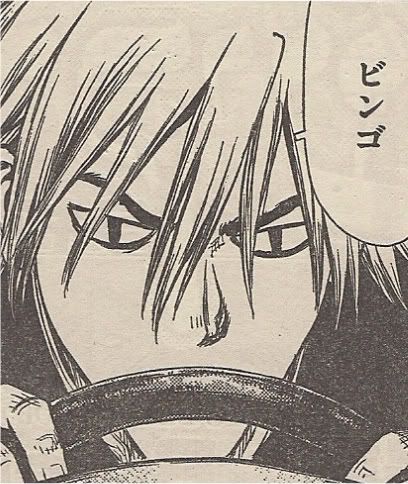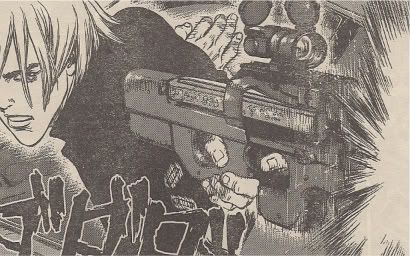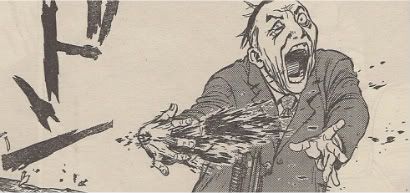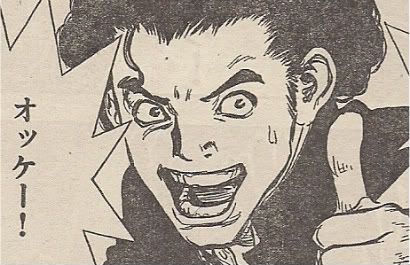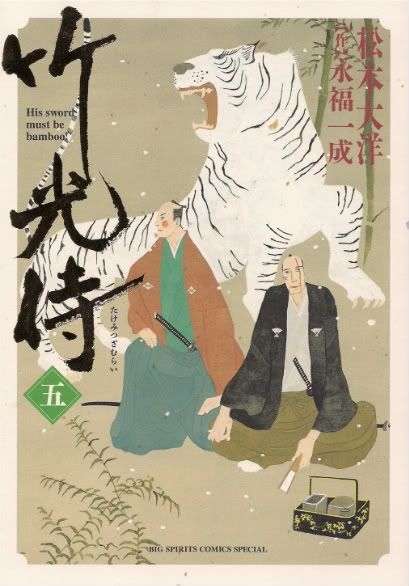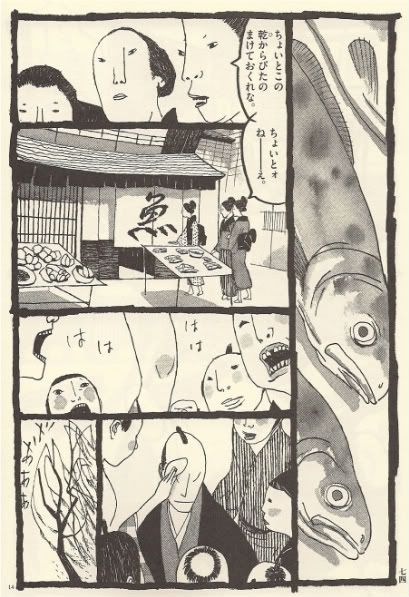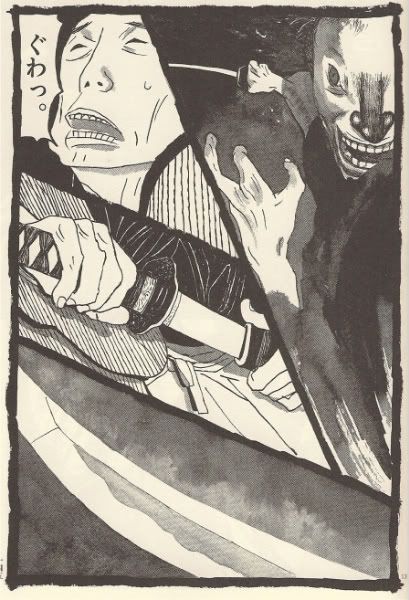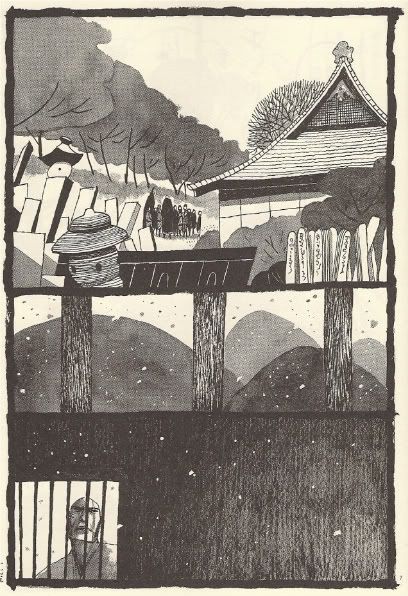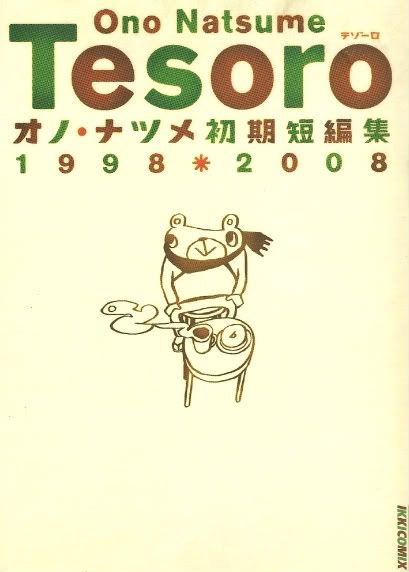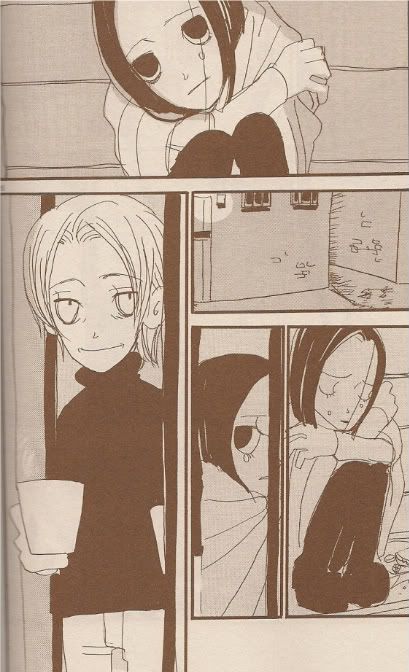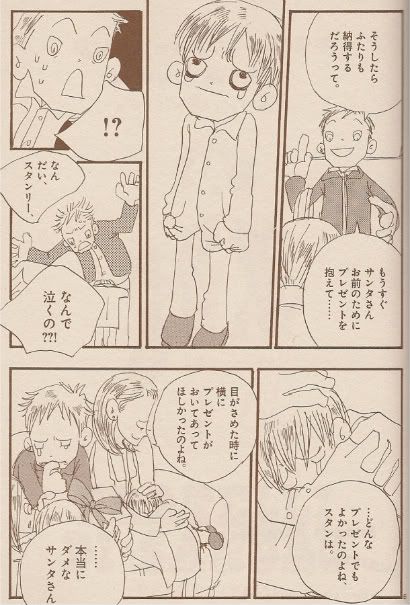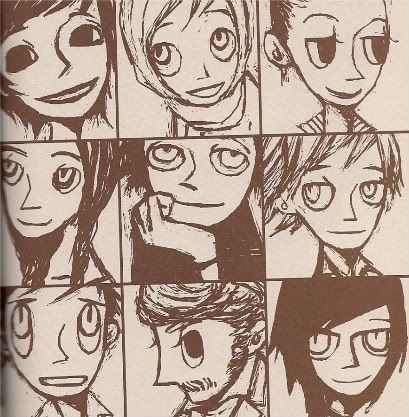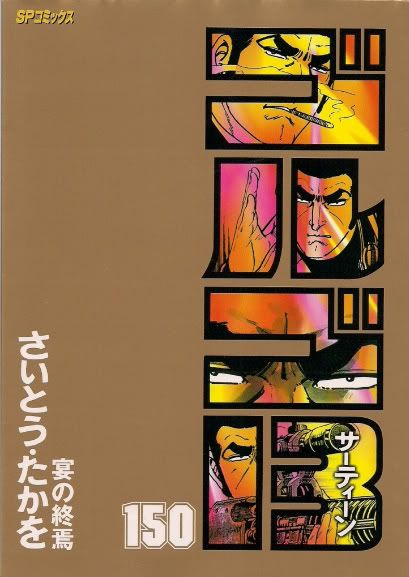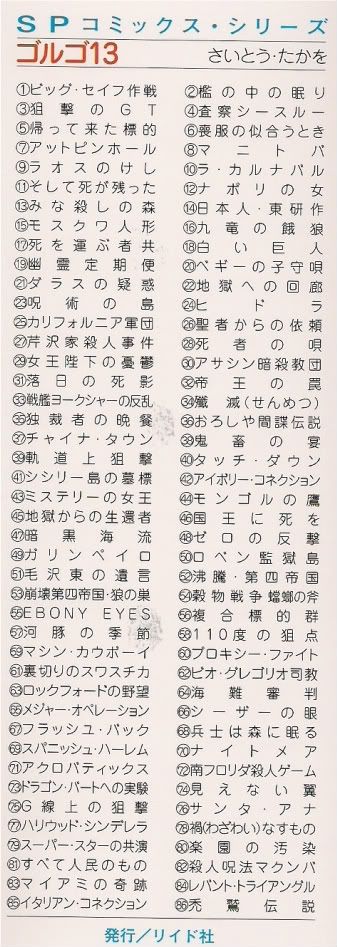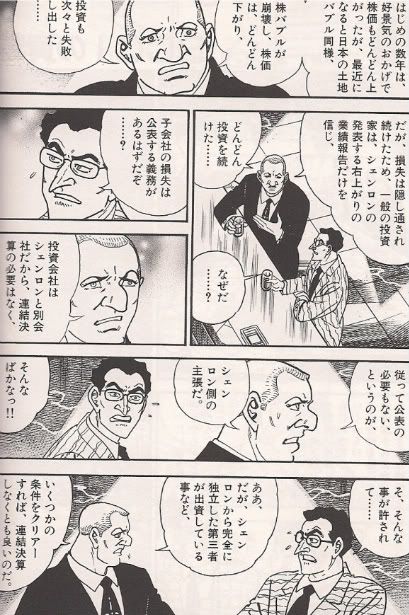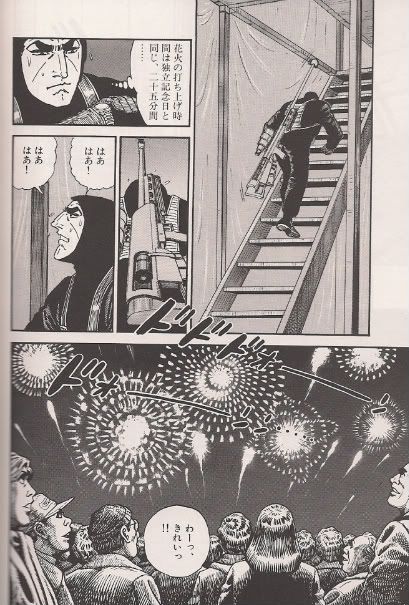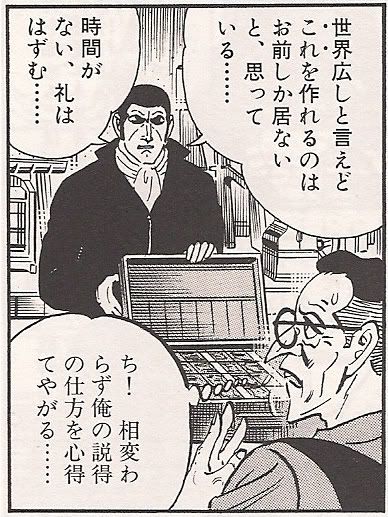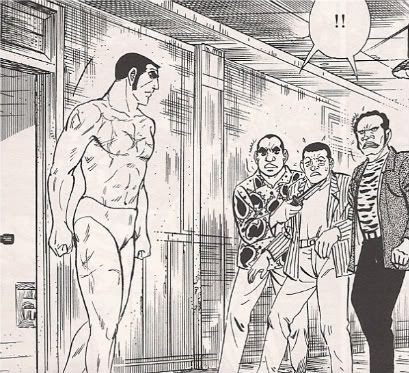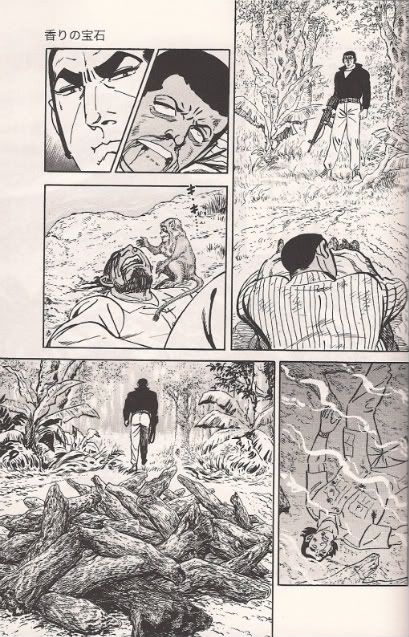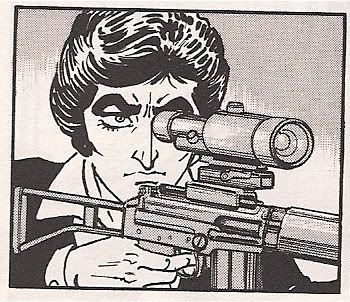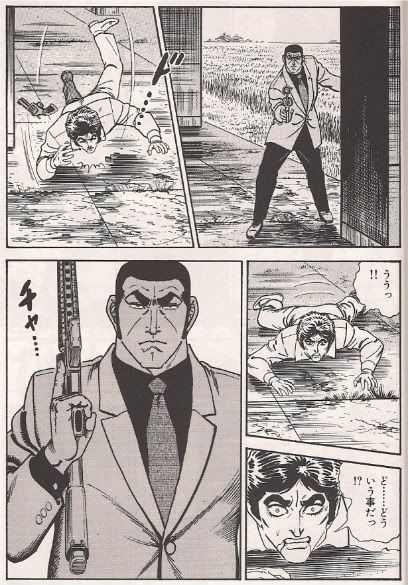MoCCA '09: The Tourist
(back to part 1)
***
VII. It was almost 2:30 when the 69th Regiment Armory came into view. Amazingly, there was still a line stretched all the way around one corner of the block; I really hoped it wasn't another fire alarm mishap, or a capacity problem, or people being turned away because they were too cool, which would definitely pose a problem for me and my gym bag of untranslated manga.
As it was, the line for tickets just happened to be that fucking long. In fact, as I'd find out later, the show hadn't even opened until 12:00 or so for a variety of reasons; "delayed books" was quoted to me. Luckily, I'd spent my morning time uptown oohing and aahing at doorways and trees. Even better: I'd pre-ordered my ticket online, so I got to walk to the front of the queue and state that I was on the list. I was sternly instructed to get a handstamp, a formless red thing that looked like I bumped the back of my palm off a table and wiped away in about two hours. Nobody checked me anyhow.
The first thing I noticed about the Armory: big. High ceiling, wide. Looming, even. But open too - you could see basically the entire show in one glance. I think there was a program, but I never found it, and I didn't really want or need one, though I'm told a bunch of folks somehow got omitted from the listings.
The second thing I noticed: it was exactly like the old venues they used to have for wrestling shows back when I was kid. My heart soared as I imagined Paul Karasik & David Mazzucchelli reuniting to land the Doomsday Device on Adrian Tomine. That's what City of Glass was all about.
Mazzucchelli already had a massive crowd formed for debut copies of Asterios Polyp; I said hello to Frank Santoro and Dash Shaw, but I didn't get in line myself. There were other things I wanted to find.
***
Pushwagners Soft City (Pushwagner)
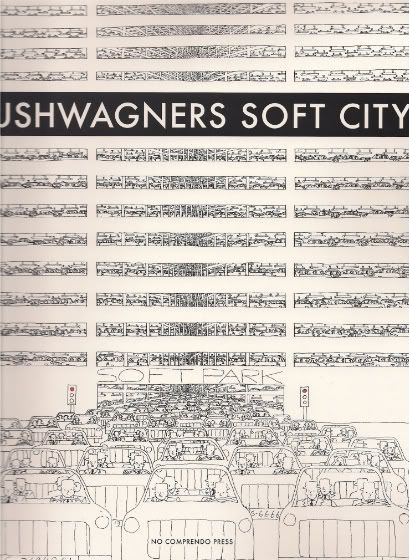
Take this, for example. A huge, thick, 160-page look-at-me book just sitting around at MoCCA with no fanfare, no line, no nothing. Seems almost scandalous in a place like this, where the attentive patron can walk in with a 3/4 shot at guessing all the 'buzz' books without looking at a damned thing, based strictly on preliminary heat. But my history books tell me scandal isn't foreign to an Armory Show, thank god.
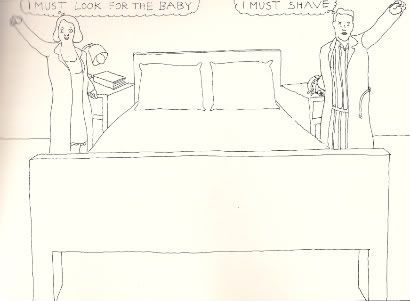
So yeah, I always hope I'll run in to something great at these shows from someone who didn't think to alert the online comics press at all, just shoving off and getting it out there; with table prices going up, there's less and less of a chance for smaller, less savvy artists to manage such surprises in the wake of well-financed (for comics), careful publishing entities.
I wouldn't say this book entirely fits that bill, but only because I was told it'd be finished soon at last year's MoCCA. It's an English-language tome from Norwegian publisher No Comprendo Press -- the web presence of which is minimal -- collecting sequential work by the artist Pushwagner, who initially completed the project in the mid-'70s, only to have the original pages lost in a suitcase until 2002, when the whole thing turned up in Oslo. It's now a $35.00 oversized softcover, in b&w with spot color, and I have no idea how you might order it.
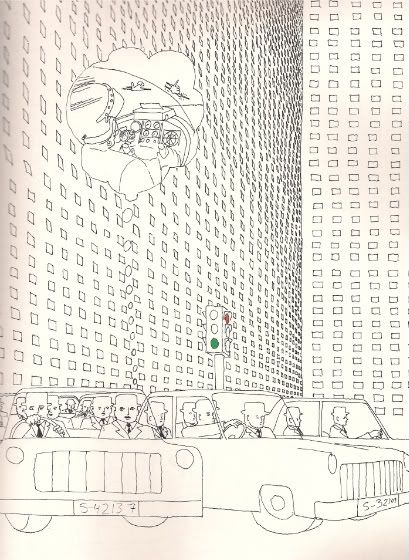
But what astonishing work! Very simple on first blush: a panorama of conformity, with office drones waking up in the morning to their Stepford wives, driving off to labor at the behest of a captain of industry while the brides 'n babies consume what they're told. The burning eye of the sun rises at the start of the book and sets at the end, so that the cycle might begin again. Odd, unreal, parodic dialogue occasionally punctures the happening; the word 'soft' is the charm telling of the comfort of this life.
Pushwagner mostly works in images: sprawling, towering single and double-page splashes, pitting simple humans against mighty towers of power and commerce. Page after page we zoom in on terrible drives to work, traffic lights some of the only color in the world; violent fantasies occasionally mark the environment, ineffectual. But while the people are tiny, and similar, their hand-drawn state quietly reminds us of their humanity, latent here, boomed out by the noise of society's mechanisms.
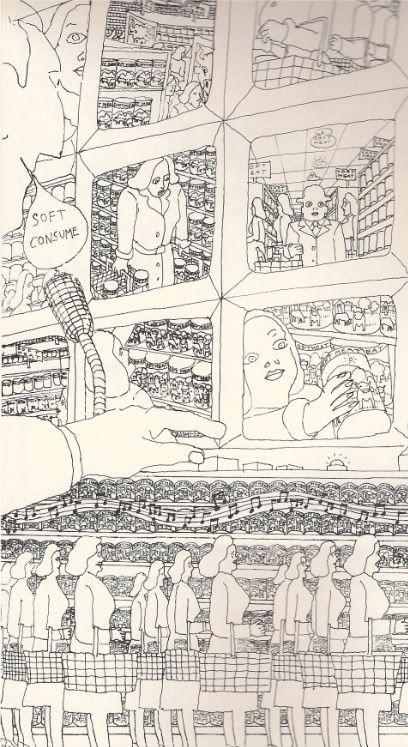
Powerful allegorical worldbuilding here. These jpegs are just details; the book won't even fit on my scanner. I'd urge you to check this out, but I'm not sure how you can do it. Keep it in mind anyway; you never know what you'll run into.
***
Angst: The Best of Norwegian Comics Vol. 3 (various)
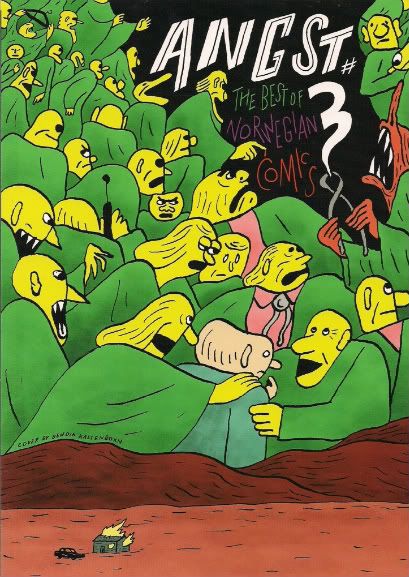
As usual for MoCCA -- new layout be damned -- there was a whole row of Scandinavian tables against the wall. And, as usual, I was happy to pick up the new Angst; it's a sort of national promotion anthology, with no credited editor, published jointly between the aforementioned No Comprendo, Jippi Comics and Dongery. Many of the same artists as seen in prior editions are included; the impression is that of a small scene, but one of variety, ranging from the careful detail of Martin Ernstsen -
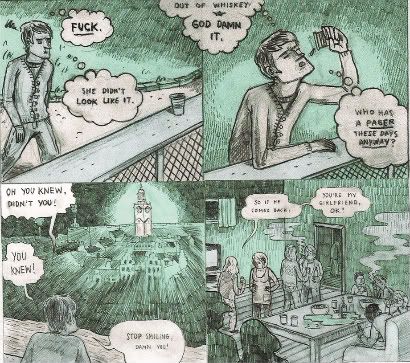
-to the happy mayhem of one Øystein Runde.
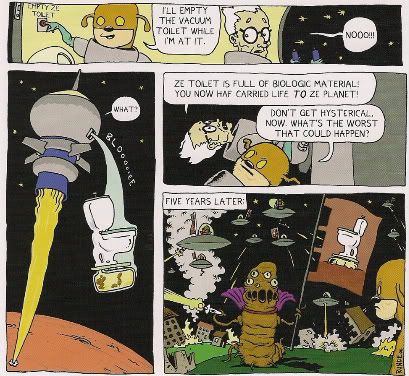
Handy things, these, although I suspect some of the artists would rather be represented in a forum not so bound by implication of national identity as its driving force. Sadly, I wound up missing out an another good-looking one, From Wonderland With Love, a very attractive collection of comics from Denmark. Do follow that link, check it out; I think Diamond might have it eventually.
***
VIII. My bag was already getting heavy, and I'd hardly had a chance to look around. Why was I sweating?
I ran downstairs to use the men's room, hoping someone would do the honor of a Duchamp joke. It didn't work out just then, but I understand Gary Panter managed as part of the next day's programming, held in the only readily open room without toilets also downstairs. Same went for Saturday.
It was easy to fall in love with that lower level; it was totally a reformed dungeon, all crumbling stone facade and ruined paint, like the old music room in my high school basement back in the day. There were vintage weapons behind glass, and entire halls roped off FOR MILITARY PERSONNEL ONLY. I presume that's where they keep the guns and ammo, but fuck that; I'm all about love from now on.
Oh, I also dug how you had to pass by military recruitment posters on the way down to the bathroom or programming. Nice touch, that.
Upon returning to the main floor, I started to notice that the temperature wasn't really changing all that much regardless of where I was in the building. "The air conditioning must be way up and quiet," I thought, unaware at the time that there was apparently no air conditioning in the building whatsoever, save for the programming room, and it was probably a massive stroke of luck that it just happened to be 15-20 degrees cooler outside than for MoCCA 2008, where people were frying eggs on the CBLDF fundraising table in spite of all modern convenience.
The PictureBox table was right in front. It was mobbed, and Dan Nadel said as much, at which point I found myself trying to keep out of the way of his business, although it was pretty clear he wanted to talk more and I didn't know what to do. People swarmed. I whacked someone with my bag, but totally not on purpose.
***
Multiforce (Mat Brinkman)

And this was maybe the fastest-moving PictureBox publication of them all that day, a $15.00, 11" x 16.5" pamphlet collection of Brinkman's Paper Rodeo feature, 2000-05.
For those who loved the near-wordless monster society observation of the artist's Teratoid Heights, this is a mutant version of that, a chatty, all-over everywhere tour of a wildly detailed fantasy landscape, full of talks and encounters. Nearly all the Fort Thunder books released in this gradual second flowering have shown a keen emphasis on society, and this one brings Brinkman's love for jagged, melty creatures more into line with the dispersed conversations of something like Brian Chippendale's Ninja, but with a special focus on consuming, identifying spaces, every page a new world.
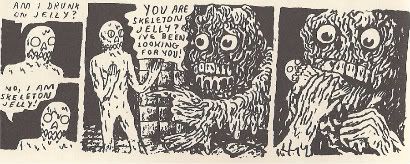
And they're big pages; up above is 4 of over 30 panels from a sample sheet; you owe it to yourself to see them all in person. I picked up two copies, one of which was for Chris Mautner. "I just know Chris'll love this," I thought, bending the pamphlet horribly while shoving it into my bag.
***
Cold Heat Special #9 (Frank Santoro & Lane Milburn)
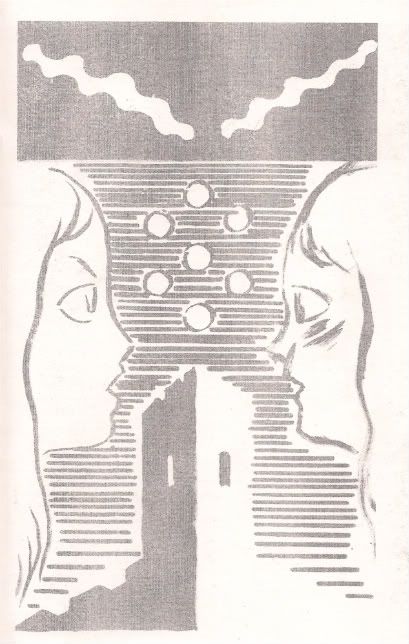
Wouldn't be an alternative comics show without one of these puppies. The side-story/fever dream freakout Cold Heat minis are now on the cusp of matching the projected issue length of the main series (issue #7/8 of which is due at SPX in a few months), and this one -- a small pamphlet with b&w covers and two-color innards -- even reunites series co-creator Santoro with Closed Caption Comics' Milburn, he of last issue, thus creating the appearance of a regular team. The story has heroine Castle looking around in a castle, and there are horses.
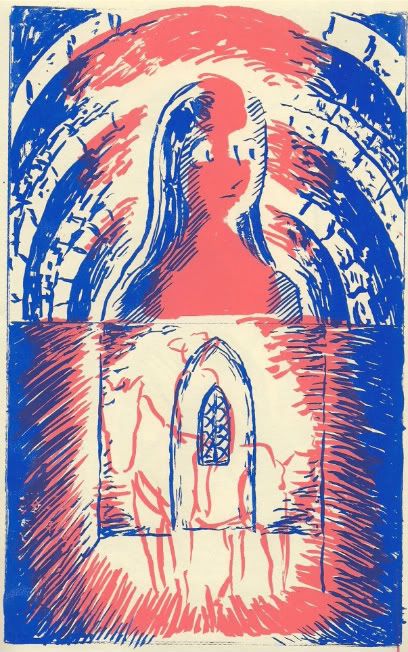
***
1-800-MICE #3 (Matthew Thurber)
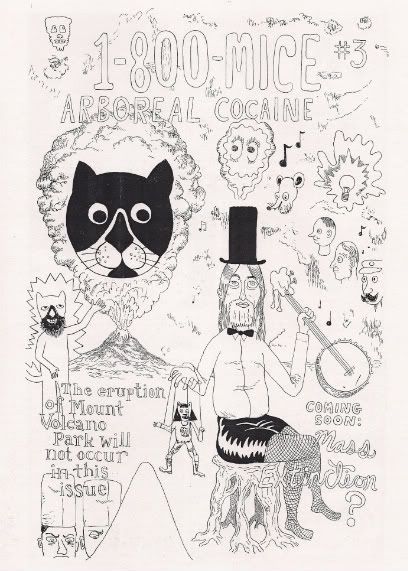
And yeah - a third issue for Thurber's funny, surreal series, which picked up a few devout readers back in the day. This one's in more of a large minicomic format, all white paper and such, but the content's just as we left it. It doesn't seem to be available online at the moment, but keep checking the PictureBox site.
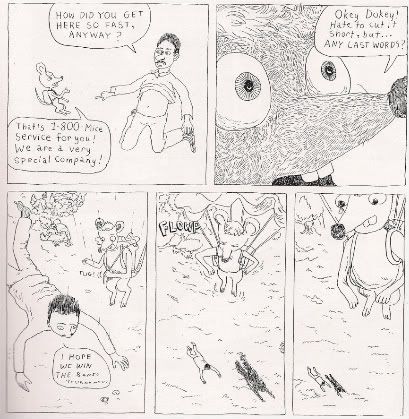
***
Epoxy #1 (of 3) (John Pham)
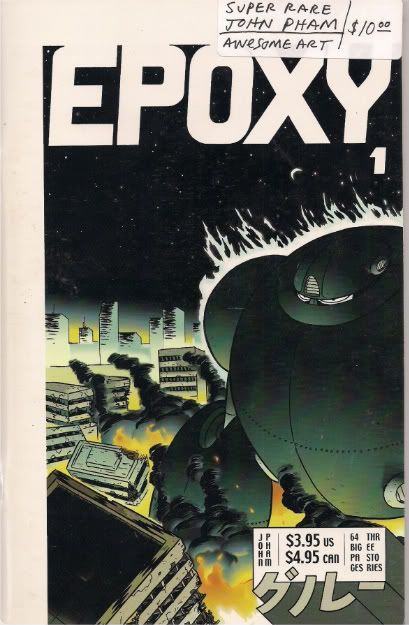
Then, of course, there's Frank Santoro's longbox.
Already a beloved staple of cons otherwise lacking in bags 'n boards, it's an exciting selection of doubles from the Santoro archives (new every time!) promising all sorts of goodies from god knows when. Supposedly there was Shaky Kane stuff that'd already sold by the time I got there; I've left my eventual purchase in-bag for the illustration above, so as to best convey Santoro's enthusiasm for putting things together (really though, you need him standing there hand-selling). A stray copy of Jimbo #4 bore a label reading "GARY PANTER INVENTED YOUR STYLE." The various Brendan McCarthy comics actually grew in excitement, until an issue of Paradax declared "BRENDAN MCCARTHY KILL KILL KILL."
This is not to be confused with the random smatter of stuff generally found at the PictureBox table, such as Real Deal. I'd actually found issue #3 of that in a back-issue bin at a local shop; the store owner looked at me in disbelief as I brought it up, like I'd snuck the comic into the store with me to play a joke and hilariously give him my money or something.
Anyway, Epoxy #1 was released in 2000, this was Pham's comics debut, at least as far as the non-minicomics world was concerned. 'Twas an olde tyme self-published one man anthology pamphlet, with three stories spread over 64 pages. Fantagraphics is releasing Pham's current series, Sublife, which doesn't bear nearly as much Euro-kissed manga influence as the stuff of yore. Now if only I could track down #2...
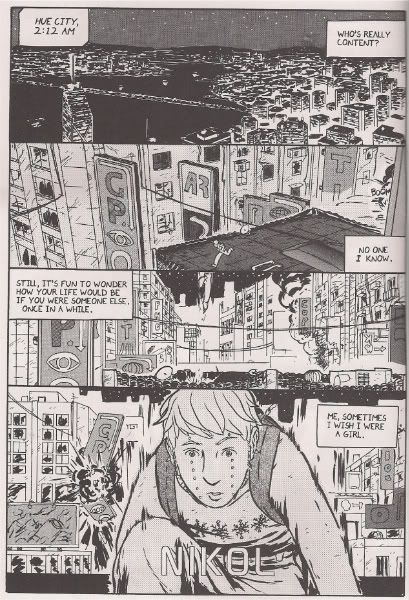
***
IX. Next up was the always-swell Bries table, home of Belgium's finest English and Dutch-language comics (they have themed anthologies too). I heard a lot of nice things about Red Riding Hood Redux, a set of five small books by Nora Krug concerning the old folk tale, very nicely designed. In fact, somebody with a big publisher was complimenting the Bries table on their book designs as I walked up and started fingerprinting everything.
"Would you like a bag?" I was asked when I'd finished.
"No. I've got bags."
It must be great to fly all the way over from Belgium for really scintillating conversation.
***
The First Book of Hope (and) The Second Book of Hope (Tommi Musturi)
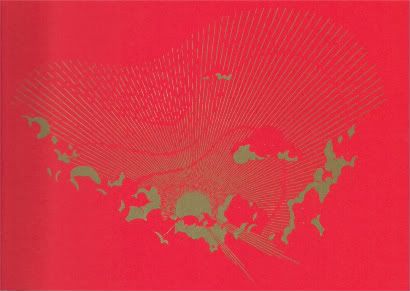
These are Bries' editions of small, 48-page landscape-format comics by Finnish artist Musturi, also the mind behind the art comics anthology GlömpX. They're works of careful, page-by-page pacing, modulated to maintain a reflective tone. A lovely, duotone color cartoon approach accompanies (and sometimes raises irony from) a man's narration of lingering anxiety; I expect Chris Ware comparisons exist somewhere, although Musturi's steady-beating narrative draws less attention to itself, remaining as quiet as puffs of breeze over thoughts. I'm told a third issue is due in a few months.
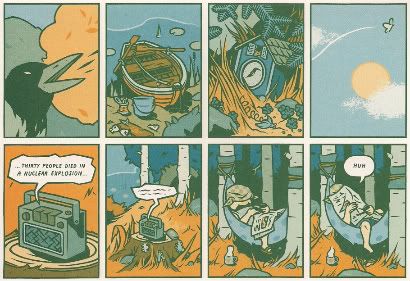
***
X. Around that time I ran into Sean T. Collins, who explained most of the situation surrounding the show's late start. It turned out the panels were late too, which all but assured I couldn't catch the Fletcher Hanks show before I had to run back for my train.
It's always good to see Sean at these things. I also ran into Douglas Wolk and Neilalien, the later of whom scoffed at my upcoming 5th anniversary of blogging - but a spring chicken! A veritable poking egg! I dug through my bag to show everyone what I bought, thus bending Chris' copy of Multiforce well beyond recognition.
I didn't get to see all the books that were recommended to me. A fair amount of people were excited over Kazimir Strzepek's The Mourning Star Vol. 2. I love Tom Gauld's work, but I sort of ran out of money before I could reach The Gigantic Robot.
Ditto for Jerry Moriarty and The Complete Jack Survives; that's a Buenaventura Press book (so is Gauld's), which means I'll probably find it easily in stores or online or something in the near future and thus and maybe shouldn't be buying it at a show, but I make exceptions for artist signings. However, Moriarty was literally walking away as I arrived -- and the Buenaventura credit card machine had a $50.00 minimum -- and I let it go for later. It was great just seeing the RAW veteran there, at his first-even signing, tall and lean with long strands of sliver hair falling against his face, like a corollary wizard out of Tolkein, the kind that isn't on the page yet somehow manages to seem there.
***
You Shall Die By Your Own Evil Creation! (ed. Paul Karasik)
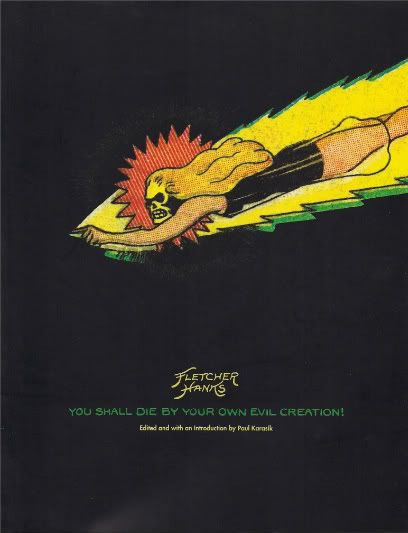
Moriarty is also a suspected Patient Zero for the Fletcher Hanks effect, having originally suggested the Golden Age auteur's work for reprinting in RAW lo those many years ago. These days Hanks is as well-known as any comic book artist of the period, mainly through the efforts of Karasik and his Fantagraphics-published megahit 2007 collection I Shall Destroy All the Civilized Planets! I mean, when Stardust gets a prominent cameo in Alan Moore's & Kevin O'Neill's newest outing for The League of Extraordinary Gentlemen, you know the culture has been duly fucking saturated.
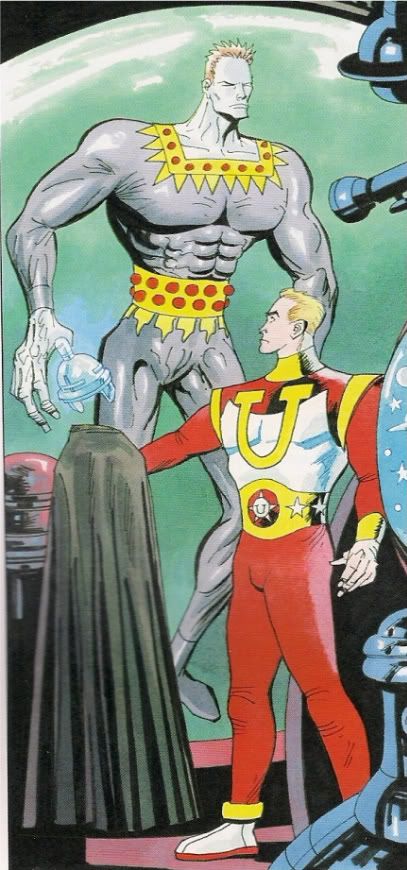
Well, IT ENDS HERE, as they say in the funnies. It's pretty fun flipping through this companion volume and seeing how it mirrors the first book: black cover in place of white, Fantomah in place of Stardust, etc. Karasik even starts the book with the final panel from his comics-format essay that closed vol. 1, and then proceeds to laungh into just what that first book lacked: a prose introduction packed with historical context. Special emphasis is placed on sorting out what Hanks isn't -- an 'outsider' artist, basically; he had formal art training, which he occasionally excelled at, and he ran in the same circles as some early comic book folk -- from the stuff that really does make him unique, like his career-spanning insistence on writing and drawing everything himself, not a universal quality in the pre-WWII comic book world.
Then it's off to the remainder of the Hanks library, although Karasik notes that some 'variant' versions of existing stories were published in places with re-drawn figures, so it's implied there may be some off-model Hanks still floating around out there. The editor also admits up front that you can track the decline of Hanks' raw funnybook power as the chronological tales move forward and page layouts become uniform, and action comics motifs become more codified. I'd also add that the first volume was pretty clearly intended as a 'best-of' project, leaving this subsequent stuff feeling a bit like leftovers. Nothing reddens the cheeks and gets the sniffles going like Stardust pounding the crap out of some dastard and turning him in to the space authorities. GAH!
But once you've got the bug, there's no getting rid of it. You'll want this, and you'll see it through 'till the end, at which point Karasik presents a reproduction of no less than Hanks' Certificate of Death. 'The end' indeed.

Fantagraphics had some fun offering show patrons good reason to buy early; while supplies lasted, your purchase got you an exclusive minicomic reprint of a Fantomah story in b&w -- it's a coloring book, you see -- with a Charles Burns portrait reproduced from a Believer cover. Something must have worked; the book sold out.
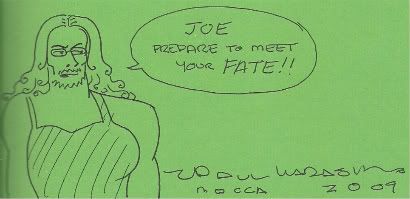
***
XI. I think I might have been the last one to get his book signed that day; right after he finished my sketch, giggling over how weird it was coming, Karasik stood up to fill in for the absent Gary Groth at the Arnold Roth/Al Jaffee panel, which was pretty obviously behind schedule. I said hello to Mike Baehr, manning the table, but I didn't stay long; it was getting pretty late, and I hadn't even made a complete run of the floor yet. I stuffed the book in my bag, and the rapidly increasingly head caused Chris' copy of Multiforce to wrap around it like a young marsupial embracing its mother, which just didn't make sense.
Moving across the room, I ran into my old friends Justin J. Fox and Marcos Pérez; they were in very good humor, particularly when I described myself as a full-time free spirit blowing across the Mountain Laurel bush of this life on Earth. I'm not sure if it was the button-down shirt or the gym bag full of comics that did it.
***
I Dreamed of You and Mr. Eyebyaninch #2 (Justin J. Fox)
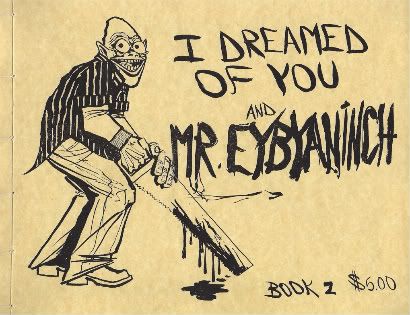
The second in Fox's series of landscape-format books, b&w and hand-stitched and 30 pages. Not a show debut or anything, but still! Fantastic journeys to the interior, doomed romance, clowns in mouths, talking creatures and sharp teeth - all curled and crossed in wide format. The lettering's aces too.
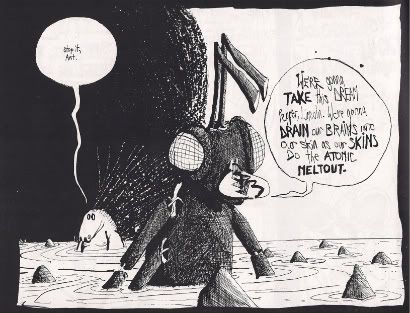
***
XII. It was 4:30 or so by then, and quickly becoming obvious what I wasn't going to be doing. Finding Tucker & Nina Stone and Matthew J. Brady, for instance. Attending many panels at all, if any. Buying even 1/5 of the European comics I liked and probably won't be seeing sitting around in person again for another year.
That last part really bugged me, so I took another look at that side of the room. I still regret not picking up some Finnish or Romanian stuff. On the plus side, though, I ran into Andrei Molotiu, editor of Fantagraphics' upcoming Abstract Comics: The Anthology, one of the books I'm most anticipating at the moment. A preview copy was available for perusal; it's a lovely book to hold and flip through, full of varied contributions from major 'names' -- Robert Crumb, Gary Panter, Lewis Trondheim, Patrick McDonnell, James Kochalka -- and new faces alike (not to mention comics bloggers Derik Badman & Noah Berlatsky). Andrei was very excited about the project, and for good reason.
***
Nautilus (Andrei Molotiu)
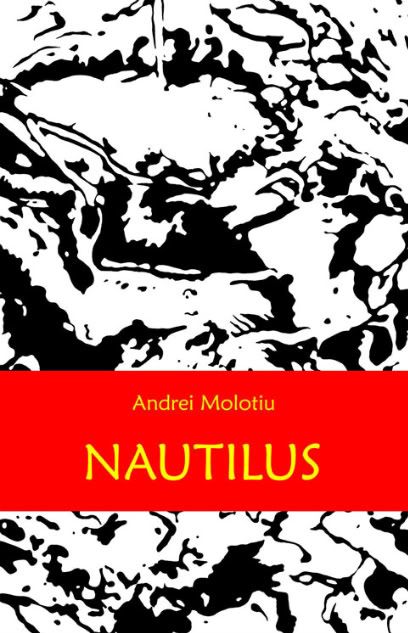
Plus, he had a new solo book for sale ($20.00) from Danish publisher Fahrenheit, an oversized album format hardcover collecting three pieces: Expedition to the Interior (from Blurred Vision Vol. 4); 24 x 24: A Vague Epic (a fittingly titled suite of 24 titled one-pagers subdivided into 24 panels each); and [otherwise untitled]. A compact, attractive introduction to the artist's work.
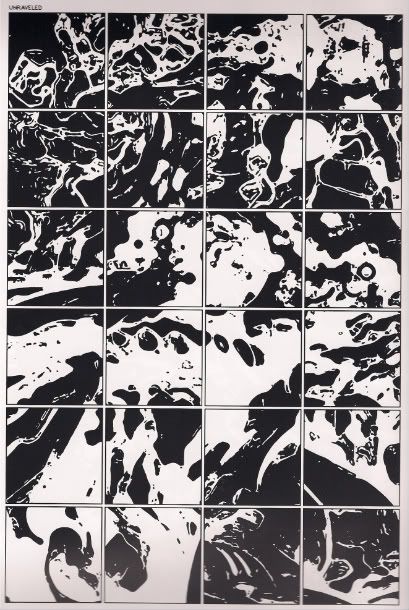
I also got a sketch, prompted by a word of my choosing: gallop. I don't have the slightest idea why I chose that, although maybe it's best such things come straight out of you with no consideration. Maybe my limited time was getting to me? This is just a detail below, by the way; Andrei wound up drawing all the way across two pages.
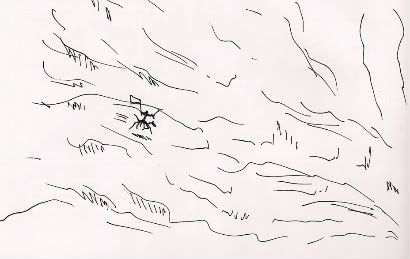
***
Reykjavik (Henrik Rehr)
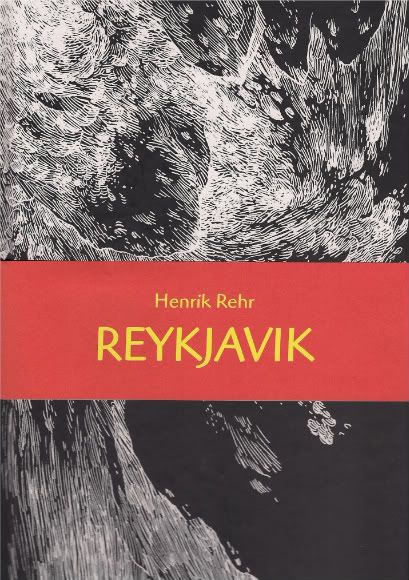
This was another book from the same publisher in the same tall, deluxe album format; Rehr was selling it for a startling $5.00. It's a single piece, a black-to-white storm of churning aquatic visuals, still every so often for primal creation forms -- roots, tendrils -- to hang in the depths. Strikes me as a creation myth, tiny square panels of activity gradually battered off into what could be called fingerprints. Potent.
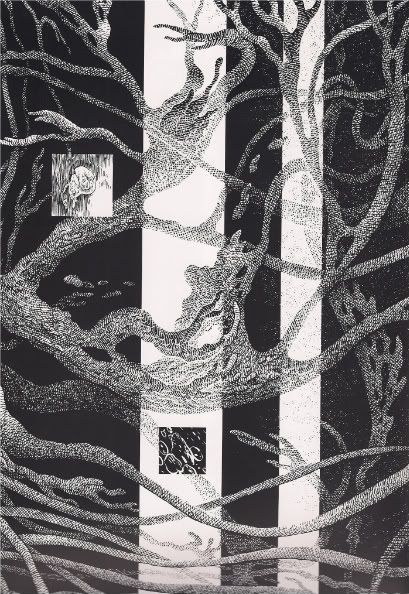
The artist wiped sweat from his brow as he sketched. Oddly, while drawn in much the same style as the splashing images of the book, the completed forms seemed more like licks of fire. Could have been the white background. Or the room.
"And now," he said, handing me my book, "I'm having a drink."
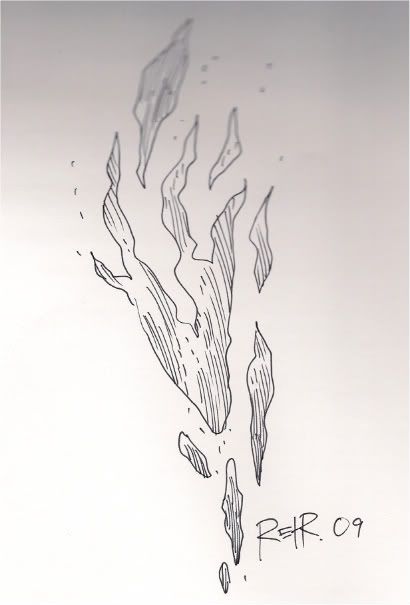
***
XIII. There was a bottled water machine by the programming room downstairs. A Poweraide machine too, priced at $1.25, which wasn't bad at all; Sean theorized that the Armory wasn't built with bilking people for their comfort in mind, and thus showed cracks in its armor of convention expectations. Probably right; if they'd wanted to drive people to buy stuff from the heat, there'd be more than two machines anyway.
I also took the opportunity to ask Sean where Kate Beacon was; it seems she wasn't listed in the program as an exhibitor (neither was Brian Wood), although I didn't know that. I just can't find anything. And I was terrified that I was going to call her 'Kate Bacon' by accident and thus precipitate a calamity. Beacon. Beacon! you fool!
***
Never Learn Anything From History (Kate Beaton)
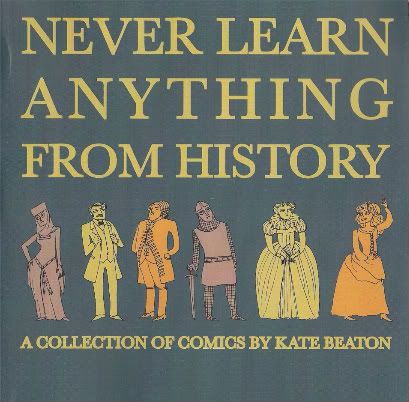
Of course, then I found out her name was Beaton.
Look - she drew me a little man:
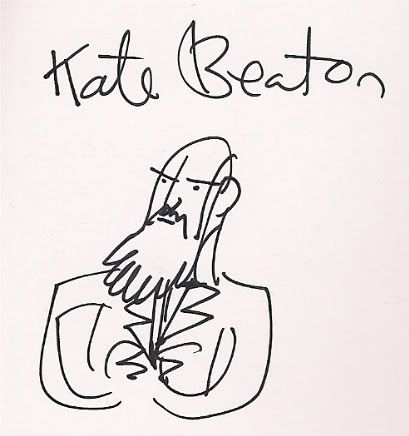
***
XIV. I'd been told Tim Hodler had arrived, so I rolled back over to the PictureBox table. It's funny, those conversations; we can all probably agree that MoCCA is primarily a consumer show. There's programming, yes, better positioned compared to the last few years', but it's mostly people walking around and buying things from folks behind tables. Comiket, only way smaller. It's not a promotional show, where the primary trade is anticipation over forthcoming products; NYCC, for instance. No, there's more of a human connection here, but it's the connection between money in one hand and items in the one across. That's the anatomy of the place, the flow of blood.
Conversation, that other human contact, stands little chance in such an environment unless you're moving around with friends from your side of the table. I usually do, although this time I didn't. I was mainly focused on the other side, the artists and merchants, busy busy. Stuffing my bag good and tight; it was starting to kill, and it was really, really hot by then. Weight and heat; books that look right, that you've heard about, but the funny thing about 'buzz' books is that they're anticipation too. Solidified, condensed, but people don't have time to read the damn things ahead of time. Not usually. They become promises, from one person to another; a separate communication, one for the sales floor, divorced from the communication of art.
You've got to extend the festival if you want something else. The money's getting tighter, and more of it's necessary. If you're attending, you stick to the programs, you look for the receptions, you go to the things afterward; there's your talking to people. In one place - the collection of everyone is the 'festival' aspect, although I could be too kind here, mistaking people gathering for something specific to one year, one place, one event.
I wouldn't be there. I'm a tourist, becoming absorbed by the urban, unfamiliar surroundings, whisked away down the vessels of the floor. It's like wandering around in NYC, but in a large room with a lot of things to buy. When the time comes, I'll leave. People will go to bed, and I'll be gone. People will sing, and I'll be gone. I felt like I needed a camera. A shirt to mark the occasion. A shirt to soak up my sweat. Oh my arm started to ache, from all of the things I bought.
Um, none of that was in my conversation with Tim. We talked about Batman and Robin #1 and Pluto and stuff. Sean was there, and Douglas for a while, and Neilalien. Tim did take a picture of that. It was nice. I dug through my bag one last time, and noticed that Chris' copy of Multiforce had become a meticulous origami duckling. Maybe I should give him my copy.
It was time to run, wrap it up.
***
George Sprott (1894-1975) (Seth)
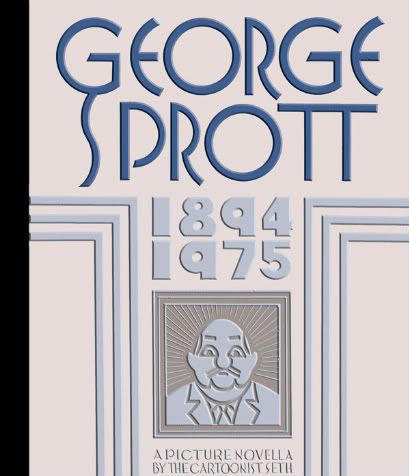
It was almost the end of the day, the line was short; I had to. Seth's jacket was on the whole time. He kept a little circle of tools to sketch with; I like how the color scheme kind of matches the book cover. Typical!
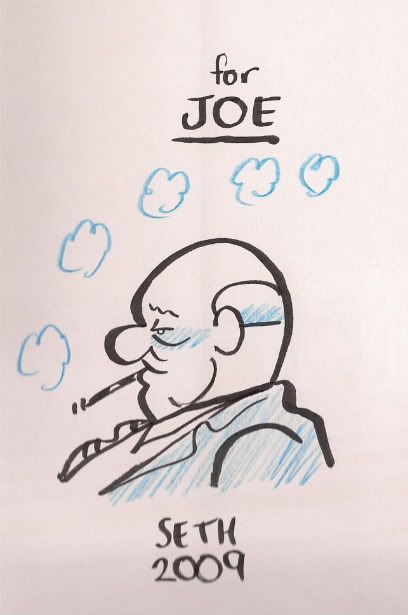
***
Windy Corner Magazine #3 (ed. Austin English)
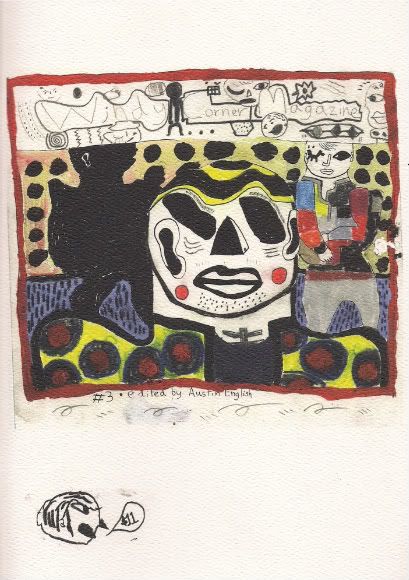
Found at the Sparkplug table; last thing I got, glad I didn't miss it. Windy Corner is a really nice pamphlet-format magazine of and about comics art, nurtured by English, an artist and perceptive critic (he used to do the Comics Journal's minicomics column). Lots of color images in this new one, which includes comics by Sakura Maku, Frank Santoro on Gipi's Garage Band, Vanessa Davis in conversation with the great Carol Tyler, and helpful illustrations by folks like Molly Colleen O'Connell:
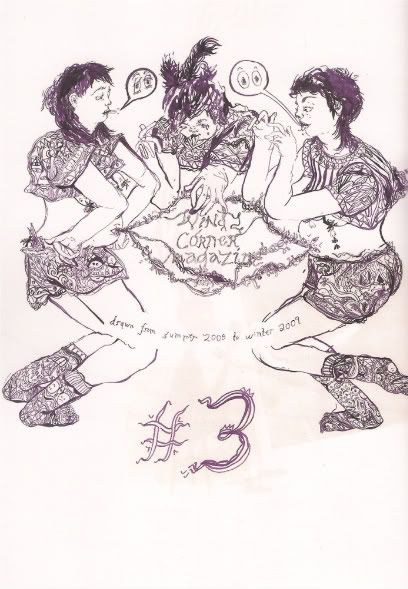
Get it from the Sparkplug site if you missed it at the show; 80 pages you won't regret for $11.00. The internet gives you time and space. Appreciate.
***
XV. And that was about the end, at 6:00. The place stayed open later than usual, I'm told, to make up for the snafus. The Fletcher Hanks show was just getting started, down in the cellar. Likely hipsters strolled up and down the streets, and I waved while thinking of Elmo. I bought a coffee, stepped around a man laying on the sidewalk, and walked off toward Penn Station.
Penn Station was a long, agonizing way off, and my bag really started to hurt. Soon I was switching arms over and over. Pausing. Giving people pause. After eight or so blocks I dropped the whole thing and faced the wall, struggling to put my shirt back together and my bones where they belonged.
In passing, I caught the eye of a woman. She was staring, but not oddly. Regarding me as unique landscape, but land nonetheless. Like I was meant to be there. Like I'd blended in as a visitor so perfectly I when then, for an instant, like something native, belonging. My sight lingered as she passed. I smiled.
***
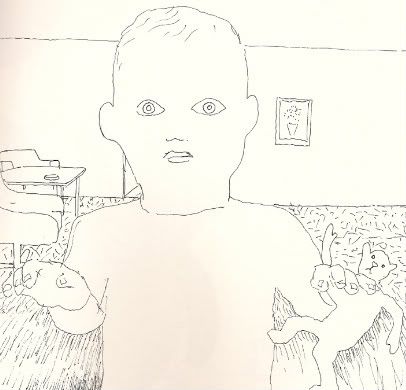
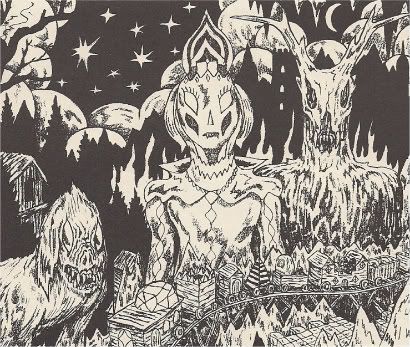
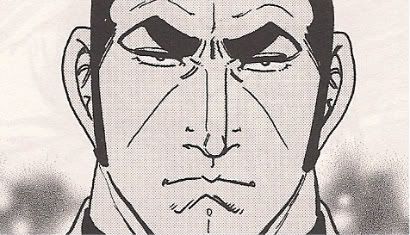
***
"My god," I whispered, "she thought I was pissing."
***
VII. It was almost 2:30 when the 69th Regiment Armory came into view. Amazingly, there was still a line stretched all the way around one corner of the block; I really hoped it wasn't another fire alarm mishap, or a capacity problem, or people being turned away because they were too cool, which would definitely pose a problem for me and my gym bag of untranslated manga.
As it was, the line for tickets just happened to be that fucking long. In fact, as I'd find out later, the show hadn't even opened until 12:00 or so for a variety of reasons; "delayed books" was quoted to me. Luckily, I'd spent my morning time uptown oohing and aahing at doorways and trees. Even better: I'd pre-ordered my ticket online, so I got to walk to the front of the queue and state that I was on the list. I was sternly instructed to get a handstamp, a formless red thing that looked like I bumped the back of my palm off a table and wiped away in about two hours. Nobody checked me anyhow.
The first thing I noticed about the Armory: big. High ceiling, wide. Looming, even. But open too - you could see basically the entire show in one glance. I think there was a program, but I never found it, and I didn't really want or need one, though I'm told a bunch of folks somehow got omitted from the listings.
The second thing I noticed: it was exactly like the old venues they used to have for wrestling shows back when I was kid. My heart soared as I imagined Paul Karasik & David Mazzucchelli reuniting to land the Doomsday Device on Adrian Tomine. That's what City of Glass was all about.
Mazzucchelli already had a massive crowd formed for debut copies of Asterios Polyp; I said hello to Frank Santoro and Dash Shaw, but I didn't get in line myself. There were other things I wanted to find.
***
Pushwagners Soft City (Pushwagner)

Take this, for example. A huge, thick, 160-page look-at-me book just sitting around at MoCCA with no fanfare, no line, no nothing. Seems almost scandalous in a place like this, where the attentive patron can walk in with a 3/4 shot at guessing all the 'buzz' books without looking at a damned thing, based strictly on preliminary heat. But my history books tell me scandal isn't foreign to an Armory Show, thank god.

So yeah, I always hope I'll run in to something great at these shows from someone who didn't think to alert the online comics press at all, just shoving off and getting it out there; with table prices going up, there's less and less of a chance for smaller, less savvy artists to manage such surprises in the wake of well-financed (for comics), careful publishing entities.
I wouldn't say this book entirely fits that bill, but only because I was told it'd be finished soon at last year's MoCCA. It's an English-language tome from Norwegian publisher No Comprendo Press -- the web presence of which is minimal -- collecting sequential work by the artist Pushwagner, who initially completed the project in the mid-'70s, only to have the original pages lost in a suitcase until 2002, when the whole thing turned up in Oslo. It's now a $35.00 oversized softcover, in b&w with spot color, and I have no idea how you might order it.

But what astonishing work! Very simple on first blush: a panorama of conformity, with office drones waking up in the morning to their Stepford wives, driving off to labor at the behest of a captain of industry while the brides 'n babies consume what they're told. The burning eye of the sun rises at the start of the book and sets at the end, so that the cycle might begin again. Odd, unreal, parodic dialogue occasionally punctures the happening; the word 'soft' is the charm telling of the comfort of this life.
Pushwagner mostly works in images: sprawling, towering single and double-page splashes, pitting simple humans against mighty towers of power and commerce. Page after page we zoom in on terrible drives to work, traffic lights some of the only color in the world; violent fantasies occasionally mark the environment, ineffectual. But while the people are tiny, and similar, their hand-drawn state quietly reminds us of their humanity, latent here, boomed out by the noise of society's mechanisms.

Powerful allegorical worldbuilding here. These jpegs are just details; the book won't even fit on my scanner. I'd urge you to check this out, but I'm not sure how you can do it. Keep it in mind anyway; you never know what you'll run into.
***
Angst: The Best of Norwegian Comics Vol. 3 (various)

As usual for MoCCA -- new layout be damned -- there was a whole row of Scandinavian tables against the wall. And, as usual, I was happy to pick up the new Angst; it's a sort of national promotion anthology, with no credited editor, published jointly between the aforementioned No Comprendo, Jippi Comics and Dongery. Many of the same artists as seen in prior editions are included; the impression is that of a small scene, but one of variety, ranging from the careful detail of Martin Ernstsen -

-to the happy mayhem of one Øystein Runde.

Handy things, these, although I suspect some of the artists would rather be represented in a forum not so bound by implication of national identity as its driving force. Sadly, I wound up missing out an another good-looking one, From Wonderland With Love, a very attractive collection of comics from Denmark. Do follow that link, check it out; I think Diamond might have it eventually.
***
VIII. My bag was already getting heavy, and I'd hardly had a chance to look around. Why was I sweating?
I ran downstairs to use the men's room, hoping someone would do the honor of a Duchamp joke. It didn't work out just then, but I understand Gary Panter managed as part of the next day's programming, held in the only readily open room without toilets also downstairs. Same went for Saturday.
It was easy to fall in love with that lower level; it was totally a reformed dungeon, all crumbling stone facade and ruined paint, like the old music room in my high school basement back in the day. There were vintage weapons behind glass, and entire halls roped off FOR MILITARY PERSONNEL ONLY. I presume that's where they keep the guns and ammo, but fuck that; I'm all about love from now on.
Oh, I also dug how you had to pass by military recruitment posters on the way down to the bathroom or programming. Nice touch, that.
Upon returning to the main floor, I started to notice that the temperature wasn't really changing all that much regardless of where I was in the building. "The air conditioning must be way up and quiet," I thought, unaware at the time that there was apparently no air conditioning in the building whatsoever, save for the programming room, and it was probably a massive stroke of luck that it just happened to be 15-20 degrees cooler outside than for MoCCA 2008, where people were frying eggs on the CBLDF fundraising table in spite of all modern convenience.
The PictureBox table was right in front. It was mobbed, and Dan Nadel said as much, at which point I found myself trying to keep out of the way of his business, although it was pretty clear he wanted to talk more and I didn't know what to do. People swarmed. I whacked someone with my bag, but totally not on purpose.
***
Multiforce (Mat Brinkman)

And this was maybe the fastest-moving PictureBox publication of them all that day, a $15.00, 11" x 16.5" pamphlet collection of Brinkman's Paper Rodeo feature, 2000-05.
For those who loved the near-wordless monster society observation of the artist's Teratoid Heights, this is a mutant version of that, a chatty, all-over everywhere tour of a wildly detailed fantasy landscape, full of talks and encounters. Nearly all the Fort Thunder books released in this gradual second flowering have shown a keen emphasis on society, and this one brings Brinkman's love for jagged, melty creatures more into line with the dispersed conversations of something like Brian Chippendale's Ninja, but with a special focus on consuming, identifying spaces, every page a new world.

And they're big pages; up above is 4 of over 30 panels from a sample sheet; you owe it to yourself to see them all in person. I picked up two copies, one of which was for Chris Mautner. "I just know Chris'll love this," I thought, bending the pamphlet horribly while shoving it into my bag.
***
Cold Heat Special #9 (Frank Santoro & Lane Milburn)

Wouldn't be an alternative comics show without one of these puppies. The side-story/fever dream freakout Cold Heat minis are now on the cusp of matching the projected issue length of the main series (issue #7/8 of which is due at SPX in a few months), and this one -- a small pamphlet with b&w covers and two-color innards -- even reunites series co-creator Santoro with Closed Caption Comics' Milburn, he of last issue, thus creating the appearance of a regular team. The story has heroine Castle looking around in a castle, and there are horses.

***
1-800-MICE #3 (Matthew Thurber)

And yeah - a third issue for Thurber's funny, surreal series, which picked up a few devout readers back in the day. This one's in more of a large minicomic format, all white paper and such, but the content's just as we left it. It doesn't seem to be available online at the moment, but keep checking the PictureBox site.

***
Epoxy #1 (of 3) (John Pham)

Then, of course, there's Frank Santoro's longbox.
Already a beloved staple of cons otherwise lacking in bags 'n boards, it's an exciting selection of doubles from the Santoro archives (new every time!) promising all sorts of goodies from god knows when. Supposedly there was Shaky Kane stuff that'd already sold by the time I got there; I've left my eventual purchase in-bag for the illustration above, so as to best convey Santoro's enthusiasm for putting things together (really though, you need him standing there hand-selling). A stray copy of Jimbo #4 bore a label reading "GARY PANTER INVENTED YOUR STYLE." The various Brendan McCarthy comics actually grew in excitement, until an issue of Paradax declared "BRENDAN MCCARTHY KILL KILL KILL."
This is not to be confused with the random smatter of stuff generally found at the PictureBox table, such as Real Deal. I'd actually found issue #3 of that in a back-issue bin at a local shop; the store owner looked at me in disbelief as I brought it up, like I'd snuck the comic into the store with me to play a joke and hilariously give him my money or something.
Anyway, Epoxy #1 was released in 2000, this was Pham's comics debut, at least as far as the non-minicomics world was concerned. 'Twas an olde tyme self-published one man anthology pamphlet, with three stories spread over 64 pages. Fantagraphics is releasing Pham's current series, Sublife, which doesn't bear nearly as much Euro-kissed manga influence as the stuff of yore. Now if only I could track down #2...

***
IX. Next up was the always-swell Bries table, home of Belgium's finest English and Dutch-language comics (they have themed anthologies too). I heard a lot of nice things about Red Riding Hood Redux, a set of five small books by Nora Krug concerning the old folk tale, very nicely designed. In fact, somebody with a big publisher was complimenting the Bries table on their book designs as I walked up and started fingerprinting everything.
"Would you like a bag?" I was asked when I'd finished.
"No. I've got bags."
It must be great to fly all the way over from Belgium for really scintillating conversation.
***
The First Book of Hope (and) The Second Book of Hope (Tommi Musturi)

These are Bries' editions of small, 48-page landscape-format comics by Finnish artist Musturi, also the mind behind the art comics anthology GlömpX. They're works of careful, page-by-page pacing, modulated to maintain a reflective tone. A lovely, duotone color cartoon approach accompanies (and sometimes raises irony from) a man's narration of lingering anxiety; I expect Chris Ware comparisons exist somewhere, although Musturi's steady-beating narrative draws less attention to itself, remaining as quiet as puffs of breeze over thoughts. I'm told a third issue is due in a few months.

***
X. Around that time I ran into Sean T. Collins, who explained most of the situation surrounding the show's late start. It turned out the panels were late too, which all but assured I couldn't catch the Fletcher Hanks show before I had to run back for my train.
It's always good to see Sean at these things. I also ran into Douglas Wolk and Neilalien, the later of whom scoffed at my upcoming 5th anniversary of blogging - but a spring chicken! A veritable poking egg! I dug through my bag to show everyone what I bought, thus bending Chris' copy of Multiforce well beyond recognition.
I didn't get to see all the books that were recommended to me. A fair amount of people were excited over Kazimir Strzepek's The Mourning Star Vol. 2. I love Tom Gauld's work, but I sort of ran out of money before I could reach The Gigantic Robot.
Ditto for Jerry Moriarty and The Complete Jack Survives; that's a Buenaventura Press book (so is Gauld's), which means I'll probably find it easily in stores or online or something in the near future and thus and maybe shouldn't be buying it at a show, but I make exceptions for artist signings. However, Moriarty was literally walking away as I arrived -- and the Buenaventura credit card machine had a $50.00 minimum -- and I let it go for later. It was great just seeing the RAW veteran there, at his first-even signing, tall and lean with long strands of sliver hair falling against his face, like a corollary wizard out of Tolkein, the kind that isn't on the page yet somehow manages to seem there.
***
You Shall Die By Your Own Evil Creation! (ed. Paul Karasik)

Moriarty is also a suspected Patient Zero for the Fletcher Hanks effect, having originally suggested the Golden Age auteur's work for reprinting in RAW lo those many years ago. These days Hanks is as well-known as any comic book artist of the period, mainly through the efforts of Karasik and his Fantagraphics-published megahit 2007 collection I Shall Destroy All the Civilized Planets! I mean, when Stardust gets a prominent cameo in Alan Moore's & Kevin O'Neill's newest outing for The League of Extraordinary Gentlemen, you know the culture has been duly fucking saturated.

Well, IT ENDS HERE, as they say in the funnies. It's pretty fun flipping through this companion volume and seeing how it mirrors the first book: black cover in place of white, Fantomah in place of Stardust, etc. Karasik even starts the book with the final panel from his comics-format essay that closed vol. 1, and then proceeds to laungh into just what that first book lacked: a prose introduction packed with historical context. Special emphasis is placed on sorting out what Hanks isn't -- an 'outsider' artist, basically; he had formal art training, which he occasionally excelled at, and he ran in the same circles as some early comic book folk -- from the stuff that really does make him unique, like his career-spanning insistence on writing and drawing everything himself, not a universal quality in the pre-WWII comic book world.
Then it's off to the remainder of the Hanks library, although Karasik notes that some 'variant' versions of existing stories were published in places with re-drawn figures, so it's implied there may be some off-model Hanks still floating around out there. The editor also admits up front that you can track the decline of Hanks' raw funnybook power as the chronological tales move forward and page layouts become uniform, and action comics motifs become more codified. I'd also add that the first volume was pretty clearly intended as a 'best-of' project, leaving this subsequent stuff feeling a bit like leftovers. Nothing reddens the cheeks and gets the sniffles going like Stardust pounding the crap out of some dastard and turning him in to the space authorities. GAH!
But once you've got the bug, there's no getting rid of it. You'll want this, and you'll see it through 'till the end, at which point Karasik presents a reproduction of no less than Hanks' Certificate of Death. 'The end' indeed.

Fantagraphics had some fun offering show patrons good reason to buy early; while supplies lasted, your purchase got you an exclusive minicomic reprint of a Fantomah story in b&w -- it's a coloring book, you see -- with a Charles Burns portrait reproduced from a Believer cover. Something must have worked; the book sold out.

***
XI. I think I might have been the last one to get his book signed that day; right after he finished my sketch, giggling over how weird it was coming, Karasik stood up to fill in for the absent Gary Groth at the Arnold Roth/Al Jaffee panel, which was pretty obviously behind schedule. I said hello to Mike Baehr, manning the table, but I didn't stay long; it was getting pretty late, and I hadn't even made a complete run of the floor yet. I stuffed the book in my bag, and the rapidly increasingly head caused Chris' copy of Multiforce to wrap around it like a young marsupial embracing its mother, which just didn't make sense.
Moving across the room, I ran into my old friends Justin J. Fox and Marcos Pérez; they were in very good humor, particularly when I described myself as a full-time free spirit blowing across the Mountain Laurel bush of this life on Earth. I'm not sure if it was the button-down shirt or the gym bag full of comics that did it.
***
I Dreamed of You and Mr. Eyebyaninch #2 (Justin J. Fox)

The second in Fox's series of landscape-format books, b&w and hand-stitched and 30 pages. Not a show debut or anything, but still! Fantastic journeys to the interior, doomed romance, clowns in mouths, talking creatures and sharp teeth - all curled and crossed in wide format. The lettering's aces too.

***
XII. It was 4:30 or so by then, and quickly becoming obvious what I wasn't going to be doing. Finding Tucker & Nina Stone and Matthew J. Brady, for instance. Attending many panels at all, if any. Buying even 1/5 of the European comics I liked and probably won't be seeing sitting around in person again for another year.
That last part really bugged me, so I took another look at that side of the room. I still regret not picking up some Finnish or Romanian stuff. On the plus side, though, I ran into Andrei Molotiu, editor of Fantagraphics' upcoming Abstract Comics: The Anthology, one of the books I'm most anticipating at the moment. A preview copy was available for perusal; it's a lovely book to hold and flip through, full of varied contributions from major 'names' -- Robert Crumb, Gary Panter, Lewis Trondheim, Patrick McDonnell, James Kochalka -- and new faces alike (not to mention comics bloggers Derik Badman & Noah Berlatsky). Andrei was very excited about the project, and for good reason.
***
Nautilus (Andrei Molotiu)

Plus, he had a new solo book for sale ($20.00) from Danish publisher Fahrenheit, an oversized album format hardcover collecting three pieces: Expedition to the Interior (from Blurred Vision Vol. 4); 24 x 24: A Vague Epic (a fittingly titled suite of 24 titled one-pagers subdivided into 24 panels each); and [otherwise untitled]. A compact, attractive introduction to the artist's work.

I also got a sketch, prompted by a word of my choosing: gallop. I don't have the slightest idea why I chose that, although maybe it's best such things come straight out of you with no consideration. Maybe my limited time was getting to me? This is just a detail below, by the way; Andrei wound up drawing all the way across two pages.

***
Reykjavik (Henrik Rehr)

This was another book from the same publisher in the same tall, deluxe album format; Rehr was selling it for a startling $5.00. It's a single piece, a black-to-white storm of churning aquatic visuals, still every so often for primal creation forms -- roots, tendrils -- to hang in the depths. Strikes me as a creation myth, tiny square panels of activity gradually battered off into what could be called fingerprints. Potent.

The artist wiped sweat from his brow as he sketched. Oddly, while drawn in much the same style as the splashing images of the book, the completed forms seemed more like licks of fire. Could have been the white background. Or the room.
"And now," he said, handing me my book, "I'm having a drink."

***
XIII. There was a bottled water machine by the programming room downstairs. A Poweraide machine too, priced at $1.25, which wasn't bad at all; Sean theorized that the Armory wasn't built with bilking people for their comfort in mind, and thus showed cracks in its armor of convention expectations. Probably right; if they'd wanted to drive people to buy stuff from the heat, there'd be more than two machines anyway.
I also took the opportunity to ask Sean where Kate Beacon was; it seems she wasn't listed in the program as an exhibitor (neither was Brian Wood), although I didn't know that. I just can't find anything. And I was terrified that I was going to call her 'Kate Bacon' by accident and thus precipitate a calamity. Beacon. Beacon! you fool!
***
Never Learn Anything From History (Kate Beaton)

Of course, then I found out her name was Beaton.
Look - she drew me a little man:

***
XIV. I'd been told Tim Hodler had arrived, so I rolled back over to the PictureBox table. It's funny, those conversations; we can all probably agree that MoCCA is primarily a consumer show. There's programming, yes, better positioned compared to the last few years', but it's mostly people walking around and buying things from folks behind tables. Comiket, only way smaller. It's not a promotional show, where the primary trade is anticipation over forthcoming products; NYCC, for instance. No, there's more of a human connection here, but it's the connection between money in one hand and items in the one across. That's the anatomy of the place, the flow of blood.
Conversation, that other human contact, stands little chance in such an environment unless you're moving around with friends from your side of the table. I usually do, although this time I didn't. I was mainly focused on the other side, the artists and merchants, busy busy. Stuffing my bag good and tight; it was starting to kill, and it was really, really hot by then. Weight and heat; books that look right, that you've heard about, but the funny thing about 'buzz' books is that they're anticipation too. Solidified, condensed, but people don't have time to read the damn things ahead of time. Not usually. They become promises, from one person to another; a separate communication, one for the sales floor, divorced from the communication of art.
You've got to extend the festival if you want something else. The money's getting tighter, and more of it's necessary. If you're attending, you stick to the programs, you look for the receptions, you go to the things afterward; there's your talking to people. In one place - the collection of everyone is the 'festival' aspect, although I could be too kind here, mistaking people gathering for something specific to one year, one place, one event.
I wouldn't be there. I'm a tourist, becoming absorbed by the urban, unfamiliar surroundings, whisked away down the vessels of the floor. It's like wandering around in NYC, but in a large room with a lot of things to buy. When the time comes, I'll leave. People will go to bed, and I'll be gone. People will sing, and I'll be gone. I felt like I needed a camera. A shirt to mark the occasion. A shirt to soak up my sweat. Oh my arm started to ache, from all of the things I bought.
Um, none of that was in my conversation with Tim. We talked about Batman and Robin #1 and Pluto and stuff. Sean was there, and Douglas for a while, and Neilalien. Tim did take a picture of that. It was nice. I dug through my bag one last time, and noticed that Chris' copy of Multiforce had become a meticulous origami duckling. Maybe I should give him my copy.
It was time to run, wrap it up.
***
George Sprott (1894-1975) (Seth)

It was almost the end of the day, the line was short; I had to. Seth's jacket was on the whole time. He kept a little circle of tools to sketch with; I like how the color scheme kind of matches the book cover. Typical!

***
Windy Corner Magazine #3 (ed. Austin English)

Found at the Sparkplug table; last thing I got, glad I didn't miss it. Windy Corner is a really nice pamphlet-format magazine of and about comics art, nurtured by English, an artist and perceptive critic (he used to do the Comics Journal's minicomics column). Lots of color images in this new one, which includes comics by Sakura Maku, Frank Santoro on Gipi's Garage Band, Vanessa Davis in conversation with the great Carol Tyler, and helpful illustrations by folks like Molly Colleen O'Connell:

Get it from the Sparkplug site if you missed it at the show; 80 pages you won't regret for $11.00. The internet gives you time and space. Appreciate.
***
XV. And that was about the end, at 6:00. The place stayed open later than usual, I'm told, to make up for the snafus. The Fletcher Hanks show was just getting started, down in the cellar. Likely hipsters strolled up and down the streets, and I waved while thinking of Elmo. I bought a coffee, stepped around a man laying on the sidewalk, and walked off toward Penn Station.
Penn Station was a long, agonizing way off, and my bag really started to hurt. Soon I was switching arms over and over. Pausing. Giving people pause. After eight or so blocks I dropped the whole thing and faced the wall, struggling to put my shirt back together and my bones where they belonged.
In passing, I caught the eye of a woman. She was staring, but not oddly. Regarding me as unique landscape, but land nonetheless. Like I was meant to be there. Like I'd blended in as a visitor so perfectly I when then, for an instant, like something native, belonging. My sight lingered as she passed. I smiled.
***



***
"My god," I whispered, "she thought I was pissing."
Labels: MoCCA09
